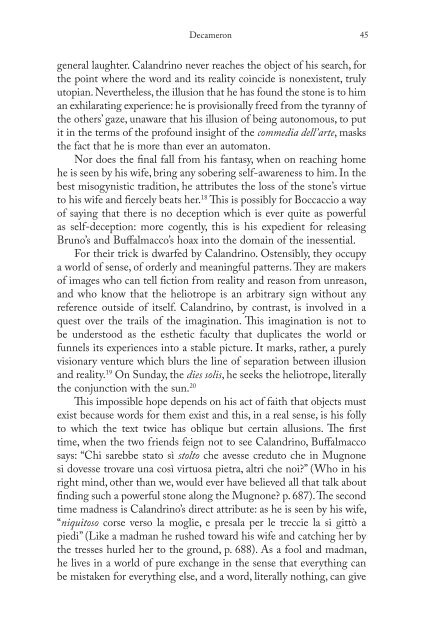Blooms Literary Themes - THE TRICKSTER.pdf - ymerleksi - home
Blooms Literary Themes - THE TRICKSTER.pdf - ymerleksi - home
Blooms Literary Themes - THE TRICKSTER.pdf - ymerleksi - home
You also want an ePaper? Increase the reach of your titles
YUMPU automatically turns print PDFs into web optimized ePapers that Google loves.
Decameron 45<br />
general laughter. Calandrino never reaches the object of his search, for<br />
the point where the word and its reality coincide is nonexistent, truly<br />
utopian. Nevertheless, the illusion that he has found the stone is to him<br />
an exhilarating experience: he is provisionally freed from the tyranny of<br />
the others’ gaze, unaware that his illusion of being autonomous, to put<br />
it in the terms of the profound insight of the commedia dell’arte, masks<br />
the fact that he is more than ever an automaton.<br />
Nor does the fi nal fall from his fantasy, when on reaching <strong>home</strong><br />
he is seen by his wife, bring any sobering self-awareness to him. In the<br />
best misogynistic tradition, he attributes the loss of the stone’s virtue<br />
to his wife and fi ercely beats her. 18 Th is is possibly for Boccaccio a way<br />
of saying that there is no deception which is ever quite as powerful<br />
as self-deception: more cogently, this is his expedient for releasing<br />
Bruno’s and Buff almacco’s hoax into the domain of the inessential.<br />
For their trick is dwarfed by Calandrino. Ostensibly, they occupy<br />
a world of sense, of orderly and meaningful patterns. Th ey are makers<br />
of images who can tell fi ction from reality and reason from unreason,<br />
and who know that the heliotrope is an arbitrary sign without any<br />
reference outside of itself. Calandrino, by contrast, is involved in a<br />
quest over the trails of the imagination. Th is imagination is not to<br />
be understood as the esthetic faculty that duplicates the world or<br />
funnels its experiences into a stable picture. It marks, rather, a purely<br />
visionary venture which blurs the line of separation between illusion<br />
and reality. 19 On Sunday, the dies solis, he seeks the heliotrope, literally<br />
the conjunction with the sun. 20<br />
Th is impossible hope depends on his act of faith that objects must<br />
exist because words for them exist and this, in a real sense, is his folly<br />
to which the text twice has oblique but certain allusions. Th e fi rst<br />
time, when the two friends feign not to see Calandrino, Buff almacco<br />
says: “Chi sarebbe stato sì stolto che avesse creduto che in Mugnone<br />
si dovesse trovare una così virtuosa pietra, altri che noi?” (Who in his<br />
right mind, other than we, would ever have believed all that talk about<br />
fi nding such a powerful stone along the Mugnone? p. 687). Th e second<br />
time madness is Calandrino’s direct attribute: as he is seen by his wife,<br />
“niquitoso corse verso la moglie, e presala per le treccie la si gittò a<br />
piedi” (Like a madman he rushed toward his wife and catching her by<br />
the tresses hurled her to the ground, p. 688). As a fool and madman,<br />
he lives in a world of pure exchange in the sense that everything can<br />
be mistaken for everything else, and a word, literally nothing, can give

















